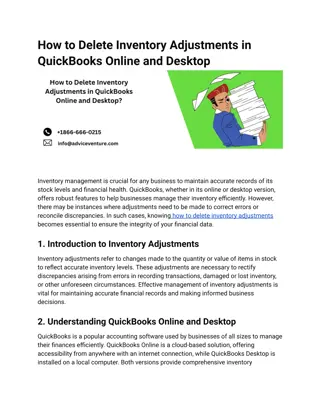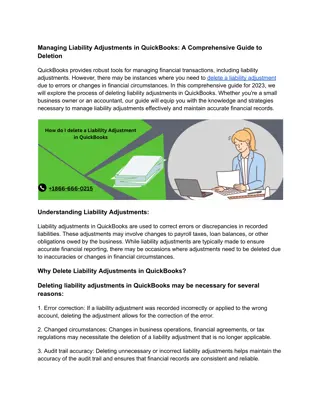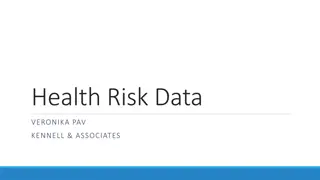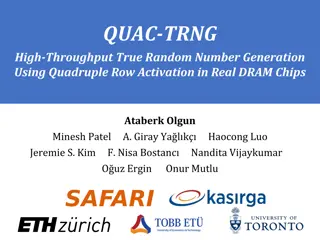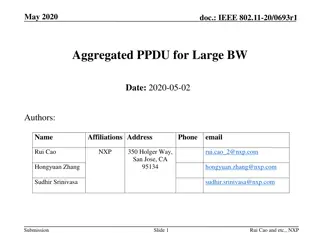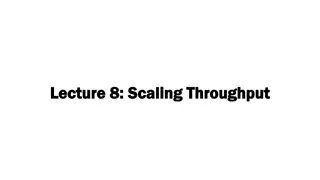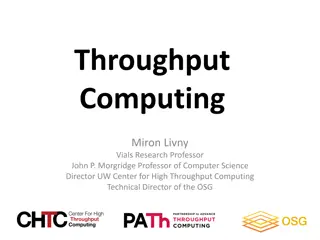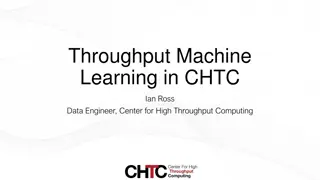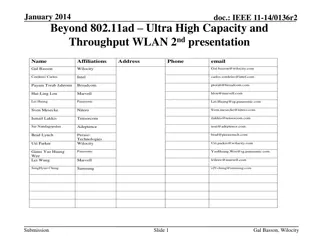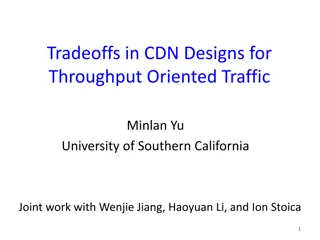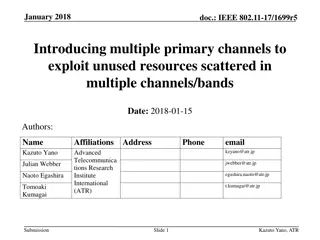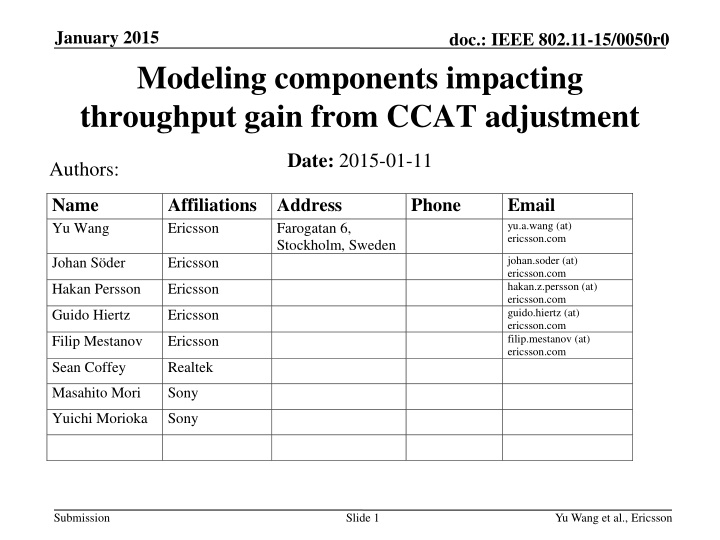
Modeling Components Impacting Throughput Gain from CCAT Adjustment
Explore the important modeling components necessary for a realistic estimation of throughput gain through CCAT adjustment in the context of IEEE 802.11 standards. Examining contributions and performance gains related to Clear Channel Assessment Threshold (CCAT) adjustment, this document delves into the comparison of modeling components, simulation scenarios, and simplified modeling elements to enhance understanding and optimization of wireless network performance.
Download Presentation

Please find below an Image/Link to download the presentation.
The content on the website is provided AS IS for your information and personal use only. It may not be sold, licensed, or shared on other websites without obtaining consent from the author. If you encounter any issues during the download, it is possible that the publisher has removed the file from their server.
You are allowed to download the files provided on this website for personal or commercial use, subject to the condition that they are used lawfully. All files are the property of their respective owners.
The content on the website is provided AS IS for your information and personal use only. It may not be sold, licensed, or shared on other websites without obtaining consent from the author.
E N D
Presentation Transcript
January 2015 doc.: IEEE 802.11-15/0050r0 Modeling components impacting throughput gain from CCAT adjustment Date: 2015-01-11 Authors: Name Yu Wang Affiliations Address Ericsson Phone Email yu.a.wang (at) ericsson.com Farogatan 6, Stockholm, Sweden johan.soder (at) ericsson.com hakan.z.persson (at) ericsson.com guido.hiertz (at) ericsson.com filip.mestanov (at) ericsson.com Johan S der Ericsson Hakan Persson Ericsson Guido Hiertz Ericsson Filip Mestanov Ericsson Sean Coffey Realtek Masahito Mori Sony Yuichi Morioka Sony Submission Slide 1 Yu Wang et al., Ericsson
January 2015 doc.: IEEE 802.11-15/0050r0 Background Some contributions show moderate gains from Clear Channel Assessment Threshold (CCAT) adjustment DSC performance [1] shows < 50% in both average and 5th percentile Other contributions show much higher gains Performance Gains from CCA Optimization [2] indicates ~200% gain in average throughput Question to answer: What are the important modelling components needed to get a more realistic estimation of the gain by adjusting CCAT? Submission Slide 2 Yu Wang et. al., Ericsson
January 2015 doc.: IEEE 802.11-15/0050r0 Background Simplified traffic modeling used Full buffer DL only Compare the effect of the following modeling components Component Simplified Realistic Spatial streams 1 (SISO) 1 to 2 (MIMO) Link adaptation ACK-based Ideal Preamble reception Always received and decoded In some cases not received or decoded Submission Slide 3 Yu Wang et. al., Ericsson
January 2015 doc.: IEEE 802.11-15/0050r0 Simulation scenario 2 20 m 20 m BSS9-12 BSS13-16 BSS24-28 BSS29-32 Enterprise Scenario as defined in [3] 8 offices, 64 cubicles per office, 2 STAs per cubicle (8 64 2) / 32 = 32 STA/AP 4 80MHz channels (8 APs on the same channel) 32 8 = 256 STAs on the same channel P2P links are not included in the simulation DL full buffer traffic BSS1-4 BSS5-8 BSS17-19 BSS20-23 2 m STA1 STA4 2 m STA2 STA3 Submission Slide 4 Yu Wang et. al., Ericsson
January 2015 doc.: IEEE 802.11-15/0050r0 Simplified modelling components SISO Ideal link adaptation SINR@Receiver before transmission used to set MCS Preamble Reception Ideal PLCP preamble decoding When two preambles arrive at the same time, both can be decoded 802.11 OFDM signal always identified Even if PLCP has already been transmitted when the sensing starts In the simplified modeling CCA-SD (preamble detection) threshold is always used, although CCA-ED threshold should be used in case the preamble is not decoded Preamble Payload AP A AP B Payload Preamble AP A AP B Preamble Payload Sensing Submission Slide 5 Yu Wang et. al., Ericsson
January 2015 doc.: IEEE 802.11-15/0050r0 More realistic modelling components MIMO Link adaptation Adaptive auto-rate fallback Preamble Reception: PLCP preamble decoding When two preambles arrive at the same time, both can be decoded only if SINR is sufficiently high 802.11 signal may not be identified If a preamble can not be detected, CCA-ED will be used Preamble Payload AP A AP B Payload Preamble AP A AP B Preamble Payload Sensing Submission Slide 6 Yu Wang et. al., Ericsson
January 2015 doc.: IEEE 802.11-15/0050r0 Average throughput gain Figure shows gain in average throughput for different CCAT compared to -82 dBm Large gains with simplified modeling Very small gains with more realistic modeling 150 simplified realistic Gain in mean throughput [%] 100 50 0 -90 -80 CCA Threshold [dBm] -70 -60 -50 Submission Slide 7 Yu Wang et. al., Ericsson
January 2015 doc.: IEEE 802.11-15/0050r0 Modeling impact on throughput -82 vs. -50 dBm CCAT: gain in average user throughput varies from 6% to 137% Model analysis for gain from reduced CCAT: MIMO: high SINR with -82 dBm can not be fully utilized by SISO transmission, higher user throughput @ -82 dBm LA: lower user throughput @ -50 dBm due to larger variations in interference PR: higher user throughput @ -82 dBm since the ED threshold (-62 dBm) is applied when an interferer s preamble is not correctly decoded Moving from simplified to more realistic modeling: Higher throughput @ -82 dBm and lower throughput @ -50 dBm The gain between -82 dBm and -50 dBm is reduced, compared to the simplified modeling gain 10 PR LA Average user throughput (Mb/s) 8 MIMO LA: link adaptation PR: preamble reception (detection & decoding) 6 Ideal,SISO Ideal,MIMO Non-ideal LA,MIMO Non-ideal PR,MIMO Non-ideal LA+PR,MIMO 4 2 0 -82 dBm -50 dBm Submission Slide 8 Yu Wang et. al., Ericsson
January 2015 doc.: IEEE 802.11-15/0050r0 Simplified models Ideal LA & PR, SISO Gain in average user throughput: 137% Gain in spatial reuse measured by AP transmitting time: 242% Loss in transmission rate: 21% Loss due to increased packet loss: 5% Relative value: 1 0.99487 0.79235 Relative value: 1 2.0807 5.6983 8 0.08 0.8 Defer Receive Transmit Collision Decoding error Average MCS rate 0.06 6 0.6 Packet loss rate AP state ratio (bits/symbol) 0.04 4 0.4 0.02 0.2 2 0 0 0 -82 dBm -70 dBm -50 dBm -82 dBm -70 dBm -50 dBm -82 dBm -70 dBm -50 dBm Submission Slide 9 Yu Wang et. al., Ericsson
January 2015 doc.: IEEE 802.11-15/0050r0 More realistic models Non-ideal LA & PR, MIMO Gain in average user throughput: 6% Gain in spatial reuse measured by AP transmitting time: 178% Loss in transmission rate: 40% Loss due to increased packet loss : 40% Relative value: 1 0.95391 0.59807 Relative value: 1 2.0696 5.7037 0.8 12 0.4 Defer Receive Transmit 10 0.6 Average MCS rate 0.3 Collision Decoding error Packet loss rate AP state ratio 8 (bits/symbol) 0.4 6 0.2 4 0.2 0.1 2 0 0 0 -82 dBm -70 dBm -50 dBm -82 dBm -70 dBm -50 dBm -82 dBm -70 dBm -50 dBm Submission Slide 10 Yu Wang et. al., Ericsson
January 2015 doc.: IEEE 802.11-15/0050r0 Summary Factors limiting user throughput gain with CCAT adjustment are identified With SISO and ideal modeling assumptions, high gain has been shown The gain in average user throughput of adjusted CCAT is reduced significantly after adding: MIMO transmission (improves baseline) Adaptive auto rate fallback link adaptation Realistic preamble detection and decoding Analysis was done for full buffer DL-only traffic, for realistic gain estimation realistic traffic model with mix of DL and UL traffic should be considered Adjusted CCAT or DSC provides system improvements [1] but more realistic modeling is important to avoid overestimation of gains Submission Slide 11 Yu Wang et. al., Ericsson
January 2015 doc.: IEEE 802.11-15/0050r0 References [1] 11-14/1427r2, DSC Performance [2] 11-14/0889r3, Performance Gains from CCA Optimization [3] 11-14/0980r5, TGax Simulation Scenarios Submission Slide 12 Yu Wang et. al., Ericsson

